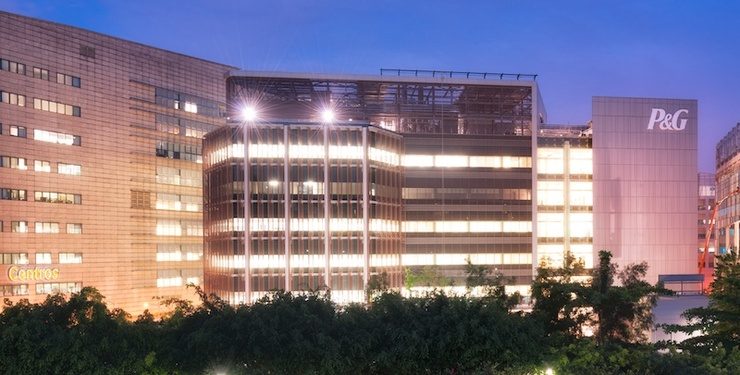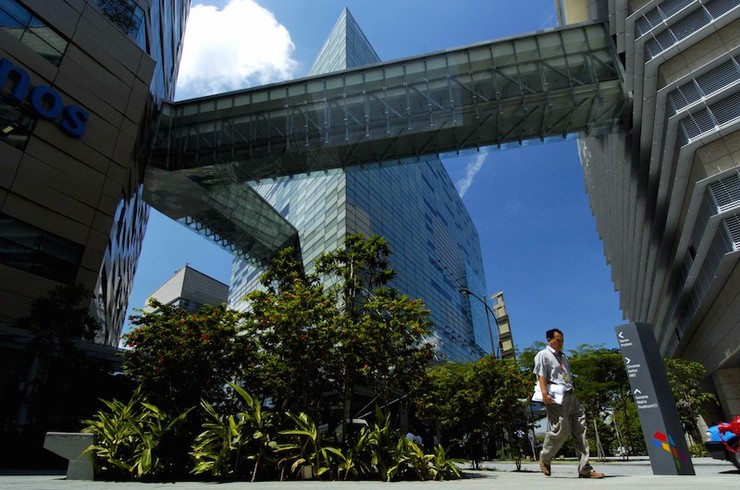SUMMARY
This is AI generated summarization, which may have errors. For context, always refer to the full article.

SINGAPORE – It looks like any other salon in a city: rows of black seats draped with the requisite capes, a slew of mirrors, neatly arranged hair care equipment, hair products lining the shelves. But it is actually a research lab.
The Wella Salon, located at the recently opened Singapore Innovation Centre (SgIC), is where consumers are allowed to test the wide range of hair care products that Procter & Gamble (P&G) has designed for Asian consumers.
The SgIC, inaugurated last March 28, is a state-of-the-art research facility focusing on the company’s hair care, skin care, home care, and personal health and grooming products. It is the largest private research center in Singapore.
Spread throughout 6 floors are over 250 laboratory modules (ranging from facilities to test hair care products, scent development, to making packaging prototypes), “collaboration areas” (meeting areas that are designed to encourage people from different units to share ideas), and facilities, such as relaxation areas. It houses around 500 staff, including scientists, engineers, and support staff.

The center is a product of the partnership between the company and the Agency for Science, Technology and Research (A*STAR), the main government agency in charge of developing the R&D sector with the aim of fostering a knowledge-based economy.
They are operating under a Master Research Collaboration Agreement (MRCA), which allows P&G and A*STAR researchers to work together on various projects.
“It’s very different with how we [usually] do partnerships,” explained Anama Dimapilis of P&G Singapore’s corporate communications division. In most cases, collaborations with external groups tend to be only for a specific project for a specific brand. With A*STAR, it is wide-ranging and cuts across a slew of product lines.
Worth around S$60 million, it is one of the company’s largest public sector research collaborations, with the funding shared between the two entities, she said.
Epicenter of biomedical research
The SgIC is located in the heart of the Biopolis – a master-planned development located in Singapore’s Buona Vista district, dedicated to the biomedical sciences research sector.
Inaugurated in 2003, it is part of the country’s vision to make the sector a key engine in the Singaporean economic machine. It was conceived at a time when the country was starting to shift from a manufacturing-driven economy to a knowledge-based one.
The complex, part of the 200-hectare one-north development, so far has a total of 13 buildings, housing a mix of A*STAR institutes, corporate laboratories, and research centers. It also has private laboratories set up by the city-state and foreign entities. Among these buildings is the SgIC, the only one occupied by a single tenant.
“It started from a few core research institutes and it’s now grown to a stable of about 10 research institutes,” says Germaine Shalla of A*STAR’s corporate communications. “We’re looking at biomedical sciences and every aspect of it.”
Biopolis – developed by A*STAR, the Economic Development Board (EDB), and developer JTC – was planned as a place for collaboration among researchers from different areas of expertise. It aims to foster multidisciplinary research in the biomedical sciences sector.

It lies close Fusionopolis, a similar complex focused on the physical sciences and engineering. Soon, the two will be joined by Mediapolis, currently under development, which will focus on emerging technologies on media and information.
It’s not all research work at Biopolis, however. It has shops, green spaces, community services, and is linked to the rest of Singapore via two MRT stations and numerous bus stops. It is a community where people work and play, fostering links among its residents inside and outside the laboratory.
Diversifying economy
The hustle and bustle at Biopolis reflects Singapore’s drive to lead in cutting-edge biomedical sciences research. It is one of two major fields – the other being physical sciences and engineering – that A*STAR has identified as crucial in diversifying the country’s economy.
“[The research agenda is] always evolving and we’re looking constantly into new areas that Singapore can look into to keep ahead of the global competition,” said Shalla.
Some of these fields are in “sunrise” industries in the biomedical arena, such as skincare, healthcare for the elderly, environment-friendly products, and food and nutrition.
One key is to attract the best companies to do their R&D in Singapore. Procter & Gamble joins the list of companies from around the world that have established research centers in Biopolis. Others also on the list include Novartis, Abbott, GlaxoSmithKline, Danone, and L’Oreal.
The city-state’s cosmopolitan nature serves as incentive for companies to establish their research arms here. “[Companies] can’t get such a cross-section of different nationalities [anywhere else],” said Shalla. “[In Singapore] you can run trials with almost every ethnic group under the Asian umbrella.”
It helps a great deal, especially when a company is working on a range of products for 4.8 billion consumers around the globe, nearly 2 billion of them living in the world’s fastest growing markets. “Companies can come in and test their products and do further research on how they can benefit Asian consumer markets,” she said.
For P&G, producing consumer goods for the Asian market means a complex process of developing and testing many formulations. Dimapilis says the diversity of the population in Singapore gives them access not just to their target markets, but also to the range of experts from various countries from a wide variety of disciplines – from designers for product packaging to the top chemical engineers for their home care products.

Little city, big science
We take the pulse of the city-state’s science and technology community, through some of its prominent institutions and centers, to see how far the country has come in terms of R&D – and what lies ahead
Collaborating with government
Dimapilis also says the level of support from the Singapore government is different compared to other countries. “It is also infrastructure-wise – they make it very easy for us to collaborate with them, with their scientists, [use] facilities.”
This is where Biopolis, Fusionopolis, and other science parks come in, bringing together various companies and research institutions and allowing them to work together at close quarters.
Singapore’s geography also comes into play: P&G’s markets around the continent are only a few hours’ flight from the island nation. This gives its product development and research teams easy access to the people they aim to serve.
“They don’t say, ‘come to us’ and say ‘this is what we need for the country.’ [Instead they say] ‘what do you need? And lets’ make it a win-win for both of us,’” Dimapilis added.
The landmark partnership between P&G and A*STAR, Dimapilis says, reflects the overall push to develop not just the biomedical sciences industry, but also the overall research and development sector in the country.
“If you are a company and you really want to level up your R&D, Singapore is the place to do it,” she said. – Rappler.com
Other stories in this series
A ‘collaboratory’ for urban solutions | A Singaporean research campus is home to local and foreign expertise in the city-state’s quest to find solutions for a changing urban landscape | Read more >>
Lowly microbes, high-tech research | A Singapore-based research institution is studying how the lowly biofilm can make an impact on environmental and public health issues | Read more >>
Add a comment
How does this make you feel?
There are no comments yet. Add your comment to start the conversation.